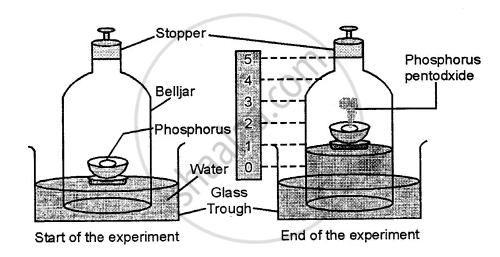Advertisements
Advertisements
प्रश्न
Describe a simple experiment to show that l/5th of air is oxygen.
उत्तर
Aim : To show that l/5th of the air is oxygen.
apparatus required : Glass trough, bell jar, stopper, water, phos-phorus, evaporating dish
PROCEDURE
- a glass trough is filled with water
- A dry evaporating dish containing white phosphorus is made to float on the water.
- This apparatus is covered with a well stoppered bell jar with markings on its side.
- A glowing iron wire is introduced into the bell jar by opening the stopper
- The phosphorus is carefully ignited.
- Re-stopper the apparatus
- The phosphorus bums with a brilliant flame farming dense white fumes of phosphorus pentoxide.
- Soon the burning ceases and the water level starts rising.
- The water occupies approximately l/5th of the original volume, as the fumes dissolve in water.
- Some phosphorus is left unburnt in the dish. The air left behind in the bell jar does not allow the phosphorus to burn.
INFERENCE : The experiment shows that the volume of air oc-cupied by oxygen is 1 /5th.

APPEARS IN
संबंधित प्रश्न
Explain the conversion of nitrogen into nitrates during lightning.
Statement given below is incorrect. Write the correct statement :
Helium gas at low pressure is used for filling electric bulbs.
State the full form of LPG and CNG? How are the two different in their composition?
State whether the following statement is ‘true’ or ‘false’. If false write the correct statement.
The mesosphere in the atmosphere, contains most of the air, fit for respiration
Name the main component of air.
How will you prove that soil contains air in it?
List uses of oxygen.
How will you show that air is dissolved in water?
Nitrogen is an essential element present in proteins and nucleic acids which are the building blocks of living things.
On a Sunday morning Paheli’s friend visited her home. She wanted to see some flowering plants in the nearby garden. Both of them went to the garden. While returning from the garden they also observed some flowering plants on the road side. But to their surprise they found that the leaves and flowers of these roadside plants were comparatively very dull. Can you help them to know why?
